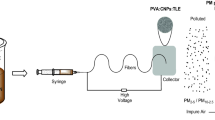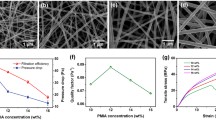Abstract
It is still a challenge to prepare a water- and polymer-based electrospun air filter film with high efficiency filtration, low pressure drop, and good mechanical properties. To address this issue, polyvinyl alcohol (PVA) was employed as the main material, mixing polyethyleneimine (PEI), bamboo-based activated carbon (BAC) and cellulose nanocrystal (CNC) to construct the air filter film by electrostatic electrospinning. In this system, the negatively charged BAC and CNC are fixed in the system through bonding with the positively charged PEI, showing a double adsorption effect. One is the mechanical filtration of the porous network structure constructed by PVA@PEI electrospun nanofibers, and the other is the electrostatic adsorption of PM2.5 on the surface of BAC and CNC. It is significant that the resulting composite air filter displays a high filtration efficiency of 95.86%, a pressure drop of only 59 Pa, and good thermal stability. Moreover, the introduced methyltrimethoxysilane (MTMS) endows it with good water-resistance. Given these excellent performances, this system can provide theoretical and technical references for the development of water- and polymer-based electrospun air filter film.
Similar content being viewed by others
References
Lelieveld J, Evans J S, Fnais M, et al. The contribution of outdoor air pollution sources to premature mortality on a global scale. Nature, 2015, 525(7569): 367–371
Pui D Y H, Chen S C, Zuo Z. PM2.5 in China: measurements, sources, visibility and health effects, and mitigation. Particuology, 2014, 13: 1–26
Anwar M N, Shabbir M, Tahir E, et al. Emerging challenges of air pollution and particulate matter in China, India, and Pakistan and mitigating solutions. Journal of Hazardous Materials, 2021, 416: 125851
Yang D, Liu Z, Yang P, et al. A curtain purification system based on a rabbit fur-based rotating triboelectric nanogenerator for efficient photocatalytic degradation of volatile organic compounds. Nanoscale, 2023, 15(14): 6709–6721
Zhu C, Yang F, Xue T, et al. Metal-organic framework decorated polyimide nanofiber aerogels for efficient high-temperature particulate matter removal. Separation and Purification Technology, 2022, 300: 121881
Sohara K, Yamauchi K, Sun X, et al. Photocatalytic degradation of polycyclic aromatic hydrocarbons in fine particulate matter (PM2.5) collected on TiO2-supporting quartz fibre filters. Catalysts, 2021, 11(3): 400
Shiraki K, Yamada H, Yoshida Y, et al. Improved photocatalytic air cleaner with decomposition of aldehyde and aerosol-associated influenza virus infectivity in indoor air. Aerosol and Air Quality Research, 2017, 17(11): 2901–2912
Sukchai P, Wanwong S, Wootthikanokkhan J. Electrospun cellulose air filter coated with zeolitic imidazolate frameworks (ZIFs) for efficient particulate matter removal: effect of coated ZIFs on filtration performance. Fibers and Polymers, 2022, 23(5): 1206–1216
Kim H J, Kim Y J, Seo Y J, et al. Hybrid bead air filters with low pressure drops at a high flow rate for the removal of particulate matter and HCHO. Polymers, 2022, 14(3): 422
Zhang H, Liu J, Zhang X, et al. Design of electret polypropylene melt blown air filtration material containing nucleating agent for effective PM2.5 capture. RSC Advances, 2018, 8(15): 7932–7941
Liu C, Dai Z, He B, et al. The effect of temperature and humidity on the filtration performance of electret melt-blown nonwovens. Materials, 2020, 13(21): 4774
Li J, Gao F, Liu L Q, et al. Needleless electro-spun nanofibers used for filtration of small particles. Express Polymer Letters, 2013, 7(8): 683–689
Ryu J, Kim J J, Byeon H, et al. Removal of fine particulate matter (PM2.5) via atmospheric humidity caused by evapotranspiration. Environmental Pollution, 2019, 245: 253–259
Chen J, Zhou Z, Miao Y, et al. Preparation of CS@BAC composite aerogel with excellent flame-retardant performance, good filtration for PM2.5 and strong adsorption for formaldehyde. Process Safety and Environmental Protection, 2023, 173: 354–365
Li C L, Song W Z, Sun D J, et al. A self-priming air filtration system based on triboelectric nanogenerator for active air purification. Chemical Engineering Journal, 2023, 452: 139428
Zhao K, Ren C, Lu Y, et al. Cellulose nanofibril/PVA/bamboo activated charcoal aerogel sheet with excellent capture for PM2.5 and thermal stability. Carbohydrate Polymers, 2022, 291: 119625
Biranje S, Madiwale P, Adivarekar R V. Electrospinning of chitosan/PVA nanofibrous membrane at ultralow solvent concentration. Journal of Polymer Research, 2017, 24(6): 92
Han W, Rao D, Gao H, et al. Green-solvent-processable biodegradable poly(lactic acid) nanofibrous membranes with bead-on-string structure for effective air filtration: “Kill two birds with one stone”. Nano Energy, 2022, 97: 107237
Rajak A, Hapidin D A, Iskandar F, et al. Controlled morphology of electrospun nanofibers from waste expanded polystyrene for aerosol filtration. Nanotechnology, 2019, 30(42): 425602
Yan G, Yang Z, Li J, et al. Multi-unit needleless electrospinning for one-step construction of 3D waterproof MF-PVA nanofibrous membranes as high-performance air filters. Small, 2023, 19(7): 2206403
Yardimci A I, Kayhan M, Tarhan O. Polyacrylonitrile (PAN)/polyvinyl alcohol (PVA) electrospun nanofibrous membranes synthesis, characterizations, and their air permeability properties. Journal of Macromolecular Science Part B: Physics, 2022, 61(10–11): 1426–1435
Wang Q, Yildiz O, Li A, et al. High temperature carbon nanotube — nanofiber hybrid filters. Separation and Purification Technology, 2020, 236: 116255
Khan M Q, Kharaghani D, Ullah S, et al. Self-cleaning properties of electrospun PVA/TiO2 and PVA/ZnO nanofibers composites. Nanomaterials, 2018, 8(9): 644
des Ligneris E, Dumée L F, Al-Attabi R, et al. Mixed matrix poly (vinyl alcohol)–copper nanofibrous anti-microbial airmicrofilters. Membranes, 2019, 9(7): 87
Nemoto J, Saito T, Isogai A. Simple freeze-drying procedure for producing nanocellulose aerogel-containing, high-performance air filters. ACS Applied Materials & Interfaces, 2015, 7(35): 19809–19815
Zhang S, Tanioka A, Okamoto M, et al. High-quality nanofibrous nonwoven air filters: additive effect of water-jet nanofibrillated celluloses on their performance. ACS Applied Polymer Materials, 2020, 2(7): 2830–2838
Abid Z, Hakiki A, Boukoussa B, et al. Preparation of highly hydrophilic PVA/SBA-15 composite materials and their adsorption behavior toward cationic dye: effect of PVA content. Journal of Materials Science, 2019, 54(10): 7679–7691
Chen Y, Cao J, Wei H, et al. Fabrication of AgNPs decorated on electrospun PVA/PEI nanofibers as SERS substrate for detection of enrofloxacin. Journal of Food Measurement and Characterization, 2022, 16(3): 2314–2322
Majumdar S S, Das S K, Saha T, et al. Adsorption behavior of copper ions on Mucor rouxii biomass through microscopic and FTIR analysis. Colloids and Surfaces B: Biointerfaces, 2008, 63(1): 138–145
Choi J H, Hong Y P, Park Y C. Spectroscopic and ligand-field properties of [L-prolylglycinato][di(3-aminopropyl) amine] chromium(III) perchlorate. Spectrochimica Acta Part A: Molecular and Biomolecular Spectroscopy, 2002, 58(8): 1599–1606
Liu Y, Huang Y, Huang Q, et al. Liquid-phase deposition functionalized wood sponges for oil/water separation. Journal of Materials Science, 2021, 56(34): 19075–19092
Kim H J, Park S J, Park C S, et al. Surface-modified polymer nanofiber membrane for high-efficiency microdust capturing. Chemical Engineering Journal, 2018, 339: 204–213
Zhang J, Lu Q, Ni R, et al. Spiral grass inspired eco-friendly zein fibrous membrane for multi-efficient air purification. International Journal of Biological Macromolecules, 2023, 245: 125512
Acknowledgements
Project funded by the China Postdoctoral Science Foundation (No. 2021M692806), the Natural Science Foundation of Zhejiang Province (No. LY21C160002), and the Scientific Research Development Foundation of Zhejiang A & F University (No. 2018FR054).
Author information
Authors and Affiliations
Corresponding authors
Ethics declarations
Declaration of competing interests The authors declare that they have no competing interests.
Rights and permissions
About this article
Cite this article
Huang, J., Wang, Y., Cai, Y. et al. Preparation of PVA@PEI@BAC@CNC composite nanofibrous film with high efficiency filtration for PM2.5. Front. Mater. Sci. 17, 230659 (2023). https://doi.org/10.1007/s11706-023-0659-3
Received:
Accepted:
Published:
DOI: https://doi.org/10.1007/s11706-023-0659-3




